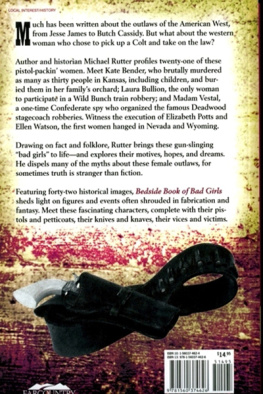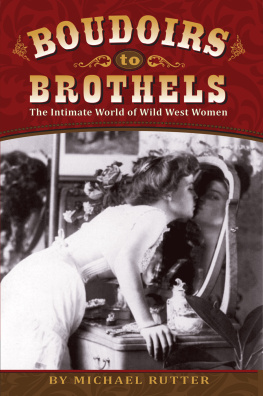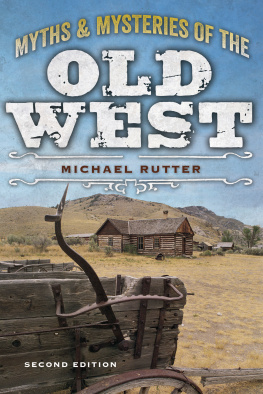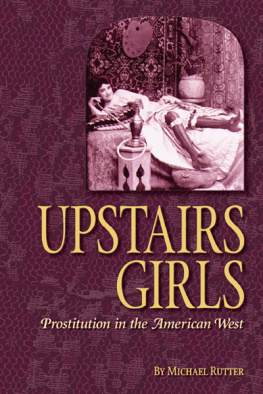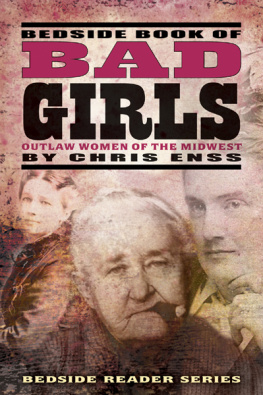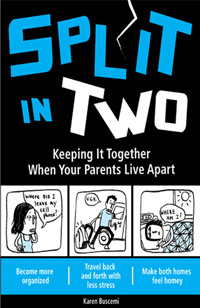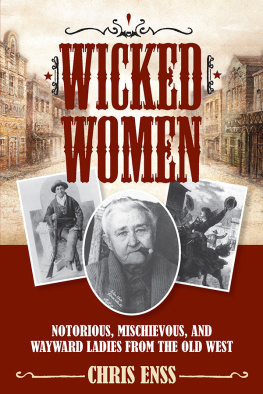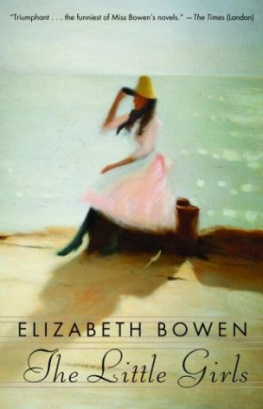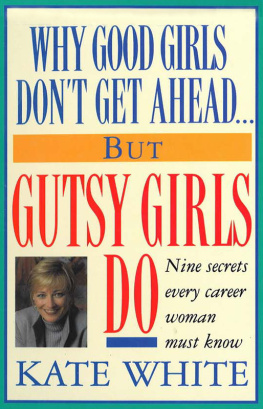
For a print copy of this book, visit www.farcountrypress.com.
Epub ISBN: 978-1-56037-535-7
Mobi pocket ISBN: 978-1-56037-537-1
Print ISBN: 978-1-56037-462-6
2008 by Farcountry Press
Text 2008 by Michael Rutter
1, 2012
All rights reserved. This book may not be reproduced in whole or in part by any means (with the exception of short quotes for the purpose of review) without the permission of the publisher.
For more information on our books, write Farcountry Press, P.O. Box 5630, Helena, MT 59604; call (800) 821-3874; or visit www.farcountrypress.com.
Part of the Bedside Reader series, which includes:
Bad Boys of the Black HillsAnd Some Wild Women, Too
By Barbara Fifer
Upstairs Girls: Prostitution in the American West
By Michael Rutter
Wanted: Wanted Posters of the Old West
By Barbara Fifer and Martin J. Kidston
INTRODUCTION
O n the western frontier, resilient men and women hacked a daunting life out of an expansive wilderness. Because of the physical demands of life in the Westwomen worked alongside men on the homesteadswestern women were not as indentured to societal conventions and traditional norms as those in the East. There was little time for fancy tea parties or parlor socials. They shot mule deer to feed the family, killed rattlesnakes in the barn, hoed corn in the July sun, and mucked out the stalls. If needed, they would perform physical labor with the men, as well as do the cooking, the cleaning, and the child rearing. They ran the ranch or farm when their husbands were away on cattle drives, getting supplies, or locating strays.
Western women achieved a greater measure of political independence than their more genteel sisters in the Eastthey were among the first to vote, serve in public office, and hold official appointments.
Many western women were as adept at living off the land as their male counterparts. A frontier woman was often skilled in the use of so-called mens tools, including firearms, which were essential for survival in the West. Many western women could use a rifle to some extent, and nearly all could point and fire the family scatter gun with deadly, albeit short-range, effect. A number could also use pistols. Most western women could saddle and bridle a horse or hitch up a team. In a large land with untold miles between spreads and towns, equestrian abilities were not a Sunday hobby; they were critical survival skills.
When a western woman committed a crime, it caused a media frenzy. Eastern audiences were fascinated with the western frontier; add a gun-totin female to the mix, and it was a hot story indeed. Journalists needed to sell their copy. If the facts didnt have enough punch, writers got creative and livened them up. For a journalist, the sin wasnt stretching the truth; the sin was telling a flat tale.
Ask people today to name the most famous outlaws in the West and theyll most likely mention Billy the Kid, Jesse James, and Butch Cassidy, among others. In addition to these outlaws, however, two other names almost always appear on the listCalamity Jane and Belle Starr.
Darlings of the eastern press, Calamity Jane and Belle Starr were two of the most infamous villains in the American West. Their deeds, however, were greatly exaggerated in order to sell papers. The two women were not superheroes, nor the gun-slinging female outlaws portrayed in newspapers, dime novels, and pulp fiction of the day. In reality, Belle Starr was little more than a horse thief. Calamity Jane was an alcoholic vagabond who resorted to prostitution and petty theft to survive.
Several female outlaws perpetrated particularly vicious crimes. Kate Bender and Ma Steffleback were some of the bloodiest serial killers in American history. Kate Bender slit the throats of her victims after bashing their brains in with a sledgehammer; Ma Steffleback reportedly watched her accomplices smash the heads of their drunken victims with the back of an ax, then picked the dead folks pockets and dumped their bodies in abandoned mine shafts.
Elizabeth Potts, the first woman hanged in Nevada, participated in a grisly murder with her husband; under her direction, he murdered a man, chopped up his body, and tried to burn the remains before burying them.
Madam Moustache was considered one of the best gamblers in the West until the drink got to her. She is said to have murdered one of her husbands after he stole everything she had worked forand she was suspected of killing another man, too.
Ah Toy, the brutal Chinese madam, abducted Chinese girls and sold them to brothels in California during the Gold Rush.
Sally Skull ran guns during the Civil War and was alleged to have killed two of her five husbands.
Although not as well known, several other women displayed a passion for the criminal life. Madam Vestal was a partner in the infamous Deadwood Stage robberies. Pearl Hart and Cora Hubbard were armed robbers; Hart held up a stage, and Hubbard participated in a bank robbery. Elizabeth Bassett, her daughters Josie and Ann, and Ellen Watson were not so much criminals as targets for big-time ranchers who falsely accused them of being rustlers in order to drive them off their land.
Little Britches and Cattle Annie were just teenagers when they started stealing. Their crimes made the front page because they were female, and because newspapers sensationalized their misdeeds. As soon as they were released from prison, they were all but forgotten.
Some of the women were labeled as outlaws because of their associations with notorious men. The members of the Wild Bunch were some of the most wanted felons in the country. The women who kept company with them were guilty by association, or sometimes were accessories. After a heist, these female companions were always eager to help spend the outlaws ill-gotten gain, and all participated in money laundering. A few even strapped on six-guns and participated in robberies. Etta Place, Annie Rogers, and Laura Bullion had prices on their heads for participation in large-scale thefts. Two of the women did hard jail time. The Rose of Cimarron, aka Rose Dunn, committed no crimes at all. The story of her outlaw exploits, complete with an invented love interest with a Doolin Gang member, was embroidered to entertain eastern readers.
Indeed, much of frontier folklore is based on tall tales and sensationalism. Thats not something we always need to apologize for. Mythology and folklore are part of our cultural literary heritage, after all, and can teach us about ourselves. But along with the wild-west hyperbole, we also need the truthwhich is often more fascinating than fiction. The women in this book were genuine people; they lived real lives, faced genuine problems, and made bad choices. They also helped shape the American West. 
SERIAL KILLERS

HARPIES MOST HORRIBLE
K ATE BENDER AND MA STEFFLEBACK WERE TWO cold-blooded murderesses who stopped at nothing to get what they wanted. Historical accounts vary, but between these two gory killers at least twenty were slain at their hands.
Kate Bender killed because she apparently liked it. Her slayings were almost ceremonial: She wielded her razor-sharp knife and slit throats like a skilled surgeon. Like her partners in crimeknown as the Bloody Bendersshe didnt seem to care if her victims were adults or children. And some of her victims are believed to have been buried alive. The Kansas City Times suggested in 1873, Nothing like this sickening series of crimes had ever been recorded in the whole history of the country.
Next page
